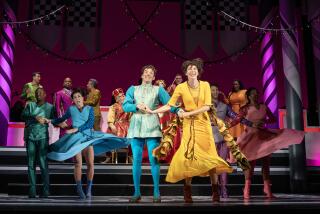Designers Transform Theater Into a Bar--and Temple
Deborah Raymond and Dorian Vernacchio don’t just build sets. They create places for plays to live in.
For Rebecca Wells’ “Gloria Duplex” (opening Sunday at the Back Alley), the husband-and-wife design team have transformed the theater into the Kitten Paradise Temple and Lounge, complete with purple walls, a functional bar, yards and yards of Christmas lights, “sacred art” (found objects re-assembled as religious monuments), a cross-shaped striptease ramp--and a dozen glitter-specked tables and chairs, which will place some of the audience members right on stage with the action.
One of the characters is an ex-rodeo star, ex-oil rig worker who runs an erotic dance club, the Kitten Paradise, explained the Baltimore-born Vernacchio. “But one time when Gloria Duplex is doing an exotic dance, she sees Jesus in the mirror ball--and she’s transformed. She becomes like a preacher, he starts making sacred art for Jesus, and they turn the place into a temple. People come from miles around to watch her do an erotic dance and see Jesus in the mirror.”
“It’s very funny, wild, crazy--and sacrilegious,” said Raymond, 29. “When we first read it, we weren’t sure if it was a spoof of these people--because they recite psalms from the Bible--or if it’s serious. It wasn’t till we met the playwright that we realized how serious it is for her.”
Wells’ point, said Vernacchio, 36, is that religion is viable anywhere, interpreted by anyone.
If it sounds as if the design team believes in the work, they do. “Not that we won’t take a job if it’s just an entertaining musical,” said Raymond. “But if it really has something to say, we feel we have to be a part of saying that. If (the thesis) is something we totally disagree with, we have to grapple with that, find a way a way to make it work for us. When we create a set, we like to be part of the whole conceptual statement--not just be another set, another room.”
The process usually begins with dual script-readings and a lot of idea-trading before anything goes on paper. In this case, those “primitive” early drawings ended up very close to the final product. The cross-shaped runway (“one of the most heavy-handed statements we’ve ever made,” New York native Raymond said cheerfully) was one of the original ideas. “And we always wanted to have the audience there. We wanted them to be in the Kitten Paradise.”
Surrounded by the “sacred art” creations of artist Craig Shepherd, audiences will enter the theater at the back of the set, and embark on a sacred art tour before they are escorted to their seats. (Thirteen theater seats have been removed to make way for the runway, replaced by small tables and chairs bordering the stage.) “We wanted to make the atmosphere more believable,” Raymond said. “At intermission, if you want (refreshments), you go to the bar.”
The duo met as students in the graduate design program at New York University. Though they often helped each other out on projects, it was years before they came together romantically--while working together on a job in Tennessee. It happened out of the blue. Reminisced Vernacchio, “We realized, ‘Hey, where have you been?’ ” Yet even after their 1984 marriage, the work stayed separate. It wasn’t till their move here 3 1/2 years ago that the marital team became a design team.
In addition to running their own shop, Scenic Arts, in Culver City, the pair has been busy racking up a resume of impressive credits, including “Borderline” (Skylight, 1985), “Curse of the Starving Class” (Tiffany, 1986), “No Place to Be Somebody” (Matrix, 1987), “Breaking the Silence,” a Los Angeles Drama Critics Circle award-winner (Pasadena Playhouse, 1988), “The Day You’ll Love Me” (Taper, Too, 1989) and “Happy Jack” (Coast, 1989).
Though Vernacchio fondly remembers the glory days of design school (“You got to do your dream concept--there’s no director and no budget”), both swear they don’t miss the autonomy of a solo career. “People change your ideas anyway: ‘I don’t want a chair over there, I want it over here ,’ ” Raymond said. “It’s sacrifices and compromises. No set is ever all yours.”
More to Read
The biggest entertainment stories
Get our big stories about Hollywood, film, television, music, arts, culture and more right in your inbox as soon as they publish.
You may occasionally receive promotional content from the Los Angeles Times.










